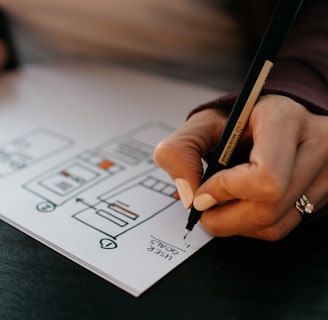How to Create Compelling Call-to-Action Buttons for Your Website
HOW-TOCONVERSIONSWEB DESIGN
10/4/20247 min read


Understanding the Importance of Call-to-Action Buttons
Call-to-action (CTA) buttons serve as crucial elements in web design, acting as prompts that guide users toward taking specific actions on a website. Whether encouraging visitors to subscribe to a newsletter, download a resource, or make a purchase, CTA buttons effectively channel user intent and engagement. The design and placement of these buttons can significantly impact conversion rates, making them essential tools for any website aiming to enhance user experience and drive desired outcomes.
Effective CTAs are often characterized by their clarity and visual appeal. A well-designed button stands out from the surrounding content, usually through contrasting colors and an engaging text that uncovers the benefit of clicking. For example, a CTA that states "Get Your Free Trial" instantly conveys value, making users more likely to convert. Conversely, vague language can lead to confusion, resulting in decreased user interaction.
Key Elements of an Effective Call-to-Action Button
Creating an effective call-to-action (CTA) button involves careful consideration of several key elements, each of which plays a significant role in its overall performance. The clarity of the message presented on the button is paramount. Users should immediately understand what action is being requested. Phrases like “Sign Up Now” or “Get Your Free Trial” clearly convey the intended purpose, encouraging users to take the desired action without hesitation.
The color of the CTA button is another critical factor. A color that contrasts well with the background not only helps the button stand out but also enhances visibility. For instance, a bright orange button on a white background draws the eye, drawing attention to the action being advocated. Furthermore, the psychological impact of color should not be overlooked; colors can evoke specific feelings and associations that can enhance the likelihood of users engaging with the button.
Size also matters in the design of a CTA button. It is essential to ensure the button is large enough to catch the user's attention, yet not so large that it disrupts the user experience on the page. A well-sized button should be visually appealing while also being easily clickable on both desktop and mobile devices.
Placement of the CTA button is crucial as well. Positioning it in a prominent location, such as above the fold or at the end of an engaging piece of content, can significantly affect its visibility and click-through rate. Additionally, incorporating sufficient white space around the button helps it stand out without overwhelming the surrounding content, allowing it to effectively lead users to the next step in their journey.
Writing Compelling Copy for CTA Buttons
Creating compelling call-to-action (CTA) buttons is crucial for driving user engagement on a website. The verbal aspect of these buttons plays a significant role in influencing user behavior, as concise and persuasive language can greatly enhance click-through rates. To write effective CTA copy, it is essential to focus on clarity, urgency, and personalization.
Firstly, the language used on a CTA button should be direct and action-oriented. Phrases such as "Get Started," "Download Now," or "Join Free for a Month" are straightforward and make it clear what users can expect upon clicking. By using strong action verbs, you emphasize the immediate action users should take, which can motivate them to proceed.
Incorporating a sense of urgency is another effective strategy. Adding phrases like "Limited Time Offer" or "Act Now" encourages users to take prompt action, tapping into their fear of missing out (FOMO). When users feel that an opportunity is fleeting, they are more likely to click through and engage with the content.
Furthermore, personalization can significantly enhance the effectiveness of your CTAs. Employing language that speaks directly to the audience's needs or interests, such as "Claim Your Discount Today" or "Find Your Perfect Match," fosters a connection between the user and the action they are being urged to take. Tailoring the message to resonate with the user's experiences can increase the chances of engagement.
Ultimately, the wording of your CTA buttons can make a substantial impact on their effectiveness. By prioritizing concise, persuasive language and integrating elements of urgency and personalization, you can create compelling CTAs that drive user interaction and boost conversion rates on your website.
The Role of Design and Aesthetics in CTA Buttons
Design plays a pivotal role in the effectiveness of call-to-action (CTA) buttons on your website. A well-designed CTA can significantly influence user interaction and drive conversions. There are several visual elements to consider that can enhance a button's visibility and effectiveness, thereby encouraging visitors to take action.
One of the most critical aspects of design is color contrast. A CTA button should stand out from the background of the webpage to catch the user's attention. Utilizing contrasting colors not only enhances visibility but also conveys urgency and encourages immediate action. For example, if a website’s main color scheme consists of muted tones, incorporating a vibrant color like orange or green for the CTA can draw the eye and prompt clicks. Additionally, the psychological implications of colors should not be overlooked; colors such as red can evoke excitement, while blue can foster trust.
Font choice also contributes significantly to the aesthetics and readability of CTA buttons. It is essential to select fonts that are legible across devices and sizes. Using bold and easily recognizable typefaces can further improve visibility. The size of the text should also be proportionate to the button itself; fonts that are too small can easily go unnoticed, while overly large fonts might appear unprofessional and cluttered.
Additionally, the shape of the button is a design element that impacts usability. Rounded corners are often perceived as more inviting, while sharp edges lend a more formal appearance. Testing different shapes can help determine which evokes the desired response from users. Furthermore, brand consistency is essential in button design. Maintaining uniform colors, fonts, and shapes in CTAs helps reinforce brand identity and builds familiarity with users, enhancing the likelihood of interaction.
By considering these factors—color contrast, font choice, button shape, and brand consistency—website owners can create compelling call-to-action buttons that effectively guide users toward the desired actions.
Best Practices for CTA Button Placement
Strategic placement of Call-to-Action (CTA) buttons is essential for optimizing user engagement and driving conversions on a website. The primary goal is to ensure that these buttons are easily visible and accessible, making it convenient for users to take the desired action. Context plays a crucial role in CTA effectiveness; buttons should be placed where they naturally fit within the content. For instance, if a blog post concludes with insights and a suggestion to sign up for a newsletter, positioning the CTA button right after these insights can encourage immediate action.
Another important aspect of effective CTA placement is the utilization of white space. Using white space creates a visual break and can draw attention to the CTA buttons, allowing them to stand out amidst other elements on the page. A cluttered layout may overwhelm users, making it harder for them to focus on the intended action. Hence, incorporating sufficient white space around the CTA buttons not only emphasizes their importance but also enhances the overall readability of the webpage.
Additionally, position CTAs above the fold whenever possible, as this is typically where visitors' attention is most concentrated when they first land on a page. This location ensures that users encounter the call-to-action without needing to scroll, increasing the likelihood of interaction. Throughout the user journey, placing CTA buttons in key locations, such as after significant information or testimonials, can effectively guide users toward conversion opportunities. For instance, if a user is reviewing options, following this with a 'Buy Now' or 'Learn More' button can prompt them to make a decision.
Overall, thoughtful placement of CTA buttons, combined with appropriate design practices, can significantly enhance user experience and increase the chances of conversion. By prioritizing visibility and context, website owners can create a seamless path for users to engage with their offerings.
A/B Testing Your Call-to-Action Buttons
A/B testing, also known as split testing, is a critical method for optimizing call-to-action (CTA) buttons on a website. This approach allows you to compare two different versions of a CTA button to determine which one performs better in persuading visitors to take the desired action. By systematically testing various elements, you can significantly enhance the effectiveness of your CTAs, ultimately leading to improved conversion rates.
To get started with A/B testing your CTA buttons, first identify the specific elements you wish to analyze. Common components include button color, text content, size, shape, and placement on the page. For instance, changing the color of a CTA button can impact its visibility and allure. Research suggests that certain colors may evoke specific emotions, influencing user behavior. Similarly, the text of the CTA button should be clear, concise, and compelling, prompting interactions. Phrases such as "Get Started" or "Download Now" can be more effective than vague alternatives.
Once you have established the elements to test, create two versions of your CTA button—version A and version B. It is crucial to ensure that only one variable is changed at a time so that you can accurately attribute any differences in performance to that specific change. Utilize website testing tools to evenly distribute traffic between the two versions and gather data on user interactions.
After you have run your tests for a sufficient duration, analyze the results to evaluate which CTA button led to higher conversion rates. Examine metrics such as click-through rates and overall user engagement. This data will guide you in making informed decisions regarding which design elements to incorporate into your final CTA button. By continuously testing and refining your calls-to-action, you can ultimately drive greater user engagement and enhance your website’s performance significantly.
Common Mistakes to Avoid with CTA Buttons
Creating effective call-to-action (CTA) buttons is crucial for optimizing user engagement and conversion rates on a website. However, many designers and website owners often fall prey to common pitfalls that undermine the efficacy of these buttons. One of the most frequent mistakes is the use of vague or ambiguous language. Phrases like "Click Here" or "Learn More" do not provide sufficient context for users, regarding the action they are about to take. Instead, using descriptive text—such as "Download Your Free E-Book" or "Get a Quote Today"—can clearly convey what users can expect after clicking, leading to higher conversion potential.
Another prevalent mistake is overcrowding the page with too many CTA buttons. While it might seem beneficial to provide multiple options, excessive buttons can overwhelm users, ultimately leading to decision fatigue. A cluttered design may cause users to abandon their intended action altogether. Instead, it is advisable to prioritize and limit the number of CTAs on a page. Fewer, well-placed buttons can direct users effectively and encourage them toward a specific action, thus enhancing overall user experience.
Additionally, neglecting the importance of visual hierarchy can detract from the CTA's impact. If a button blends into the design of the website, it may go unnoticed, regardless of the urgency of the message. Utilizing contrasting colors, appropriate sizing, and strategic placement can make CTA buttons stand out and capture users' attention. Finally, disregarding the mobile experience when designing CTAs can also be detrimental. As more users access websites via mobile devices, ensuring that buttons are appropriately sized and positioned for mobile viewing is essential for achieving desired engagement.
